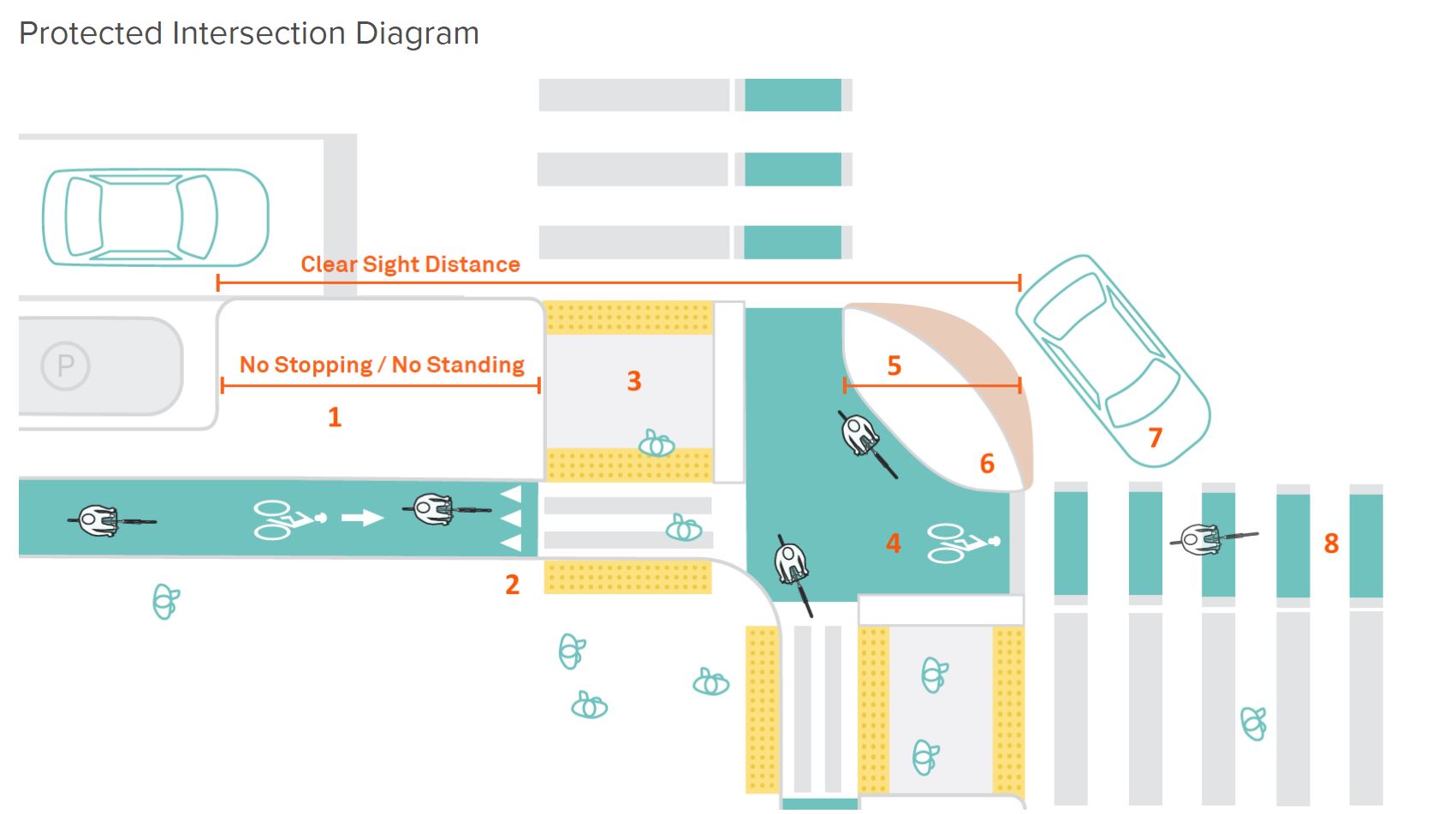- Home
- »
- ...
- »
- Community Development
- »
- Engineering
- »
- Protected Intersections
Protected Intersections
Protected intersections are designed to keep bicycles physically separate from cars up until the intersection while providing a high degree of comfort and safety for people of all ages and abilities.
The design of a protected intersection can reduce the likelihood of high-speed vehicle turns, improve sightlines, and dramatically reduce the distance and time during which people on bikes and pedestrians are exposed to conflicts. Protected intersections have been implemented across North America as cities continue to reevaluate their transportation infrastructure and gradually start incorporating non-vehicular transportation designs.
Making Protected Intersections in Visalia
As part of that effort, the City of Visalia is also reevaluating our transportation infrastructure and is currently considering the addition of protected intersections to our city. Currently, the City of Visalia is considering protected intersections in the following locations:
How Do Protected Intersections Work?
At protected intersections, the bikeway is set back from the parallel motor vehicle traffic. Unlike at conventional bike intersections, people biking are not forced to merge into mixed traffic. Instead, they are given a dedicated path through the intersection, and have the right of way over turning motor vehicles.
The setback (5) between the motor vehicle lane and the bikeway makes people on bikes more easily visible to turning drivers than in a conventional intersection. Bike yield lines (2) can also be incorporated to remind people on bikes to yield to pedestrians.
Corner islands (6) anchor the design, extending the protected bike lane’s separation as far into the intersection as possible and tightening the corner’s turn radius. They create a bike queue area (4) after the crosswalk, a natural place for people on bikes to wait.
The setback creates a waiting zone (7) for turning cars where drivers can yield to bikes after starting to turn, but before crossing the path of oncoming bicycles. If the setback is large enough, it lets drivers wait while through-traffic passes them, relieving pressure to turn too quickly.
Protected intersections also provide shorter, safer crossings for people walking. With low-speed vehicle turns and room for accessible pedestrian islands (3), people on foot and those using personal mobility devices benefit from curb extensions.
Protected intersections create shorter, simpler crossings, more predictable movements, and better visibility between pedestrians, people on bikes and people driving. The space for all transportation modes is clearly defined by incorporating the bike specific crossing markings (8), as a result, the intersection is more comfortable and safer for all transportation modes traversing the intersection.
Image Credit: National Association of City Transportation Officials (NACTO)
How Do I Travel Through a Protected Intersection?
It’s important to know how to navigate a protected intersection. While they may look like a typical intersection, there are some important differences, especially for those on bikes. The City of San Luis Obispo produced a concise and detailed video on the operation of a signalized protected intersection:
Although the video produced by the City of San Luis Obispo is specific to a signalized intersection, the various characteristics and how to traverse the intersection will apply to the City of Visalia’s application along County Center Drive. The corner islands will be implemented using striping configuration and tactile treatments to keep vehicles in their lane and make pedestrians and people on bikes more visible.
Tips for Driving in a Protected Intersection
- When making a right turn, be sure to always keep the corner island to your right.
- Do not Drive over or through the marked corner island area.
- Avoid the striped corner islands and tactile surface, these areas are designed to accommodate larger vehicles that require wider turns.
- Look for bicycles in the bike lane, which will be traveling on your righthand side.
- Yield to pedestrians in the crosswalk, as you would at a typical intersection.


Tips for Bike Riders
Riding a bike through a protected intersection is similar to riding through a typical intersection. The biggest difference are left hand turns, which are made safer thanks to protected intersections.
- Ride in the bike lane to approach the intersection.
- Stop at the stop bar or designated queuing area (activate push button to cross; for a signalized intersection, if applicable), proceed through the intersection when its safe to do so (at stop controlled intersection) or following the green light if signalized.
- Ride through the intersection in the green bike lane to connect to the bike lane on the other side of the intersection.
- To turn right, stay in the bike lane and turn right without stopping, unless there are specific markings. Be sure to yield to pedestrians accordingly.
- To make a left turn, always proceed in a counterclockwise direction like you would in a roundabout to avoid merging across lanes of traffic.
- Ride along the dedicated bike lane to the opposite corner island across the intersection, turn left and wait at the stop bar or limit line. Proceed following the green light if signalized or proceed when safe to do at stop-controlled intersection.
- Always yield to pedestrians in the crosswalk, as you would at a typical intersection.

Tips for Walkers
When using a protected intersection as a pedestrian, use the pushbutton where applicable and cross the intersection following pedestrian signal head queue where signalized. For stop-controlled intersections, cross when it is safe to do so like you would at a typical intersection. Be sure to take care to look out for vehicles and bicyclists as you enter and exit the intersection.
For more information or questions about protected intersections, please contact Diego Corvera, Civil Engineer at (559) 713-4209 or [email protected].

